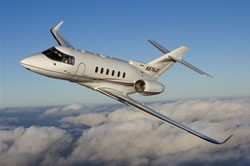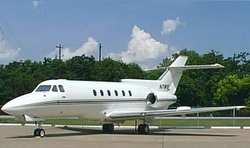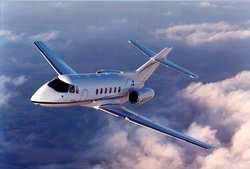A Popular Jet... By Any Name
 An aircraft type that's
seen its share of names celebrated something of a milestone this
week... as Raytheon Aircraft Company delivered the 800th Hawker
125-800-series aircraft, a Hawker 850XP, to an Arkansas-based home
shopping company.
An aircraft type that's
seen its share of names celebrated something of a milestone this
week... as Raytheon Aircraft Company delivered the 800th Hawker
125-800-series aircraft, a Hawker 850XP, to an Arkansas-based home
shopping company.
The delivery is the most recent accomplishment in the long
history of the best selling mid-size business aircraft of all
time... as the plane we now know as the Hawker 800 has been
available for sale, in one form or another, for 44 years... from
four different manufacturers.
The original 125 business jet that started it all was first
conceived by the De Havilland Aircraft Company. It first flew in
1962, with a Rolls Royce Viper 520 turbojet engine.
By 1968, the airplane had undergone several engine changes and
other airframe modifications to reflect the latest standards. The
De Havilland Aircraft Company by that time had been bought by the
Hawker Siddeley Corporation and the 125 series aircraft (shown
at right) became better known simply as the "Hawker".
 In 1971, the Hawker
airframe experienced its first big change -- a fuselage stretch of
two feet. The 600 series featured the 3,750 lb. Rolls Royce Viper
601 turbojet engine, a 25,000 lb. takeoff weight and a range of
over 1,500 nm.
In 1971, the Hawker
airframe experienced its first big change -- a fuselage stretch of
two feet. The 600 series featured the 3,750 lb. Rolls Royce Viper
601 turbojet engine, a 25,000 lb. takeoff weight and a range of
over 1,500 nm.
By the mid-1970s, the Garrett TFE-731 engine was fitted to the
Series 600 airframe and the Series 700 was born. The aircraft with
its new turbofan engines had double the range of the
turbojet-powered 600 even though they both had the same fuel
capacity.
In 1983, after years of developing the same basic airframe,
British Aerospace (into which Hawker Siddeley had now merged)
decided to develop the all new Series 800. This aircraft featured
the same basic cabin size as the Series 700, but incorporated a new
nose with curved windscreens, a new wing design with increased
wingspan and increased fuel capacity. The fin area was increased by
a redesigned leading edge and the rear ventral fin deleted. The
latest avionics development of Electronic Flight Information System
(EFIS) was incorporated into the increased volume flight deck.
Raytheon Company purchased British Aerospace Corporate Jets on
August 6, 1993, and renamed it Raytheon Corporate Jets. In
mid-September of 1994, Beech Aircraft and Raytheon Corporate Jets
merged to form Raytheon Aircraft Company.
 A year later, RAC built
on the success of the Hawker by introducing the Hawker 800XP
(right). Features of the aircraft included an improved
environmental system, inflight capable APU, enlarged TKS de-icing
fluid tank, aileron and tab gearing, standard thrust reversers,
improved brake energy capacity, and a small ‘vortilon’
which provided a clean wing. The airframe was strengthened which
provided increased payloads and the ability to carry full seating
capacity and full fuel load.
A year later, RAC built
on the success of the Hawker by introducing the Hawker 800XP
(right). Features of the aircraft included an improved
environmental system, inflight capable APU, enlarged TKS de-icing
fluid tank, aileron and tab gearing, standard thrust reversers,
improved brake energy capacity, and a small ‘vortilon’
which provided a clean wing. The airframe was strengthened which
provided increased payloads and the ability to carry full seating
capacity and full fuel load.
The Hawker 800XP engines were upgraded to the more powerful
TFE-731-5BR rated at 4,660 lb. each which provided the Hawker 800XP
with sparkling airfield performance particularly from hot and high
elevation airfields. The engine featured a digital electronic
control (DEEC) for excellent efficiency and minimum crew engine
monitoring. Range increased to 2,500 nm.
On February 28, 2006, Raytheon Aircraft Company announced
certification of the newest aircraft in the Hawker family, the
Hawker 850XP. With Raytheon Aircraft designed winglets, the
aircraft was the next evolution of the highly successful Hawker
800-series. A few weeks later, the first Hawker 850XP was delivered
to a customer at a special ceremony in Little Rock.
Today, the company sells the 800XP and 850XP planes that, while
obviously new and improved, still clearly pay homage to their
predecessors. Over 1,500 Hawker jets of all types are in service,
according to Raytheon.
 ANN's Daily Aero-Term (04.20.24): Light Gun
ANN's Daily Aero-Term (04.20.24): Light Gun Aero-News: Quote of the Day (04.20.24)
Aero-News: Quote of the Day (04.20.24) ANN's Daily Aero-Linx (04.21.24)
ANN's Daily Aero-Linx (04.21.24) Aero-News: Quote of the Day (04.21.24)
Aero-News: Quote of the Day (04.21.24) ANN's Daily Aero-Term (04.21.24): Aircraft Conflict
ANN's Daily Aero-Term (04.21.24): Aircraft Conflict





